
Florissantia is an extinct genus of flowering plants in the Malvaceae subfamily Sterculioideae known from western North America and far eastern Asia. Flower, fruit, and pollen compression fossils have been found in formations ranging between the Early Eocene through to the Early Oligocene periods. The type species is Florissantia speirii and three additional species are known, Florissantia ashwillii, Florissantia quilchenensis, and Florissantia sikhote-alinensis.

Tilia johnsoni is an extinct species of flowering plant in the family Malvaceae that, as a member of the genus Tilia, is related to modern lindens. The species is known from fossil leaves found in the early Eocene deposits of northern Washington state, United States and a similar aged formation in British Columbia, Canada.

Dinopanorpidae is a small family of extinct insects in the order Mecoptera (scorpionflies) that contains two genera and seven species.
Dinopanorpa is an extinct monotypic genus of scorpionfly that contains the single species Dinopanorpa megarche and is the type genus of the extinct family Dinopanorpidae. The genus is known from a single hindwing specimen, the holotype, currently deposited in the collections of the National Museum of Natural History, as number "69173", and which was first described by Dr Theodore D.A. Cockerell in 1924. The name is a combination of the Greek deino meaning "terrible" or "monstrous" and "Panorpa", the type genus of Panorpidae the family in which Dinopanorpa was first placed.

Ginkgo dissecta is an extinct ginkgo species in the family Ginkgoaceae described from a series of isolated fossil leaves. The species is known from Early Eocene sediments exposed in the province of British Columbia, Canada, and Washington, US. It is one of two Ginkgo species found at the Washington and British Columbia sites.
The Coldwater Beds are a geologic formation of the Okanagan Highlands in British Columbia, Canada. They preserve fossils dating back to the Ypresian stage of the Eocene period, or Wasatchian in the NALMA classification.
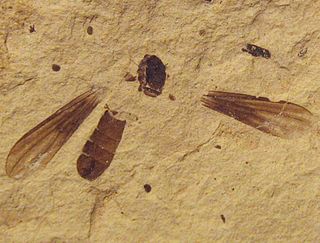
Metanephrocerus is an extinct genus of big-headed flies in the dipteran subfamily Protonephrocerinae, for which it is one of only two genera. The genus contains four described species, Metanephrocerus belgardeae, M. collini, M. groehni, and M. hoffeinsorum. Metanephrocerus is known from a group of Middle Eocene fossils which were found in Europe and a single early Eocene fossil from North America.
Wesmaelius mathewesi is an extinct species of lacewing in the neuropteran family Hemerobiidae known from an Eocene fossil found in North America
Cretomerobius is an extinct genus of lacewings in the neuropteran family Hemerobiidae known from fossils found in Asia. The genus currently contains a single species, the Aptian C. disjunctus.

Holcorpa is a genus of extinct insects in the scorpionfly order Mecoptera. Two Eocene age species found in Western North America were placed into the genus, H. dillhoffi and H. maculosa.

Ulmus okanaganensis is an extinct species of flowering plant in the family Ulmaceae related to the modern elms. The species is known from fossil leaves, flowers, and fruits found in the early Eocene deposits of northern Washington state, United States and similar aged formations in British Columbia, Canada.
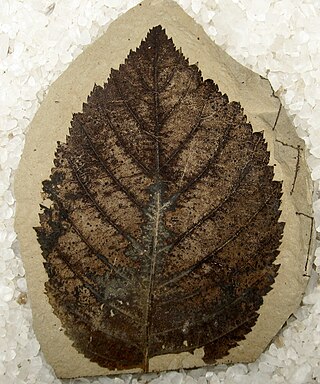
Betula leopoldae is an extinct species of birch in the family Betulaceae. The species is known from fossil leaves, catkins, and inflorescences found in the early Eocene deposits of northern Washington state, United States, and similar aged formations in British Columbia, Canada. The species is placed as basal in Betula, either as a stem group species, or an early divergent species.
Paraconcavistylon is an extinct genus of flowering plant in the family Trochodendraceae comprises a single species, Paraconcavistylon wehrii. The genus is known from fossil fruits and leaves found in the early Eocene deposits of northern Washington state, United States, and southern British Columbia, Canada. The species was initially described as a member of the related extinct genus Concavistylon as "Concavistylon" wehrii, but subsequently moved to the new genus Paraconcavistylon in 2020 after additional study.

Comptonia columbiana is an extinct species of sweet fern in the flowering plant family Myricaceae. The species is known from fossil leaves found in the early Eocene deposits of central to southern British Columbia, Canada, plus northern Washington state, United States, and, tentatively, the late Eocene of Southern Idaho and Earliest Oligocene of Oregon, United States.
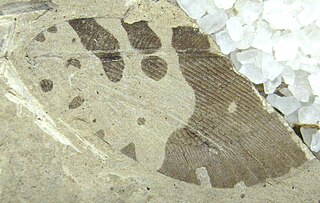
Palaeopsychops is an extinct genus of lacewing in the moth lacewings family Ithonidae. The genus is known from Early Eocene fossils found in Europe, and North America and is composed of ten species. The ten species can be informally separated into two species groups based on veination of the forewings, the "European" and "North American" groups. When first described, the genus was placed in the family Psychopsidae, but later was moved to Polystoechotidae, which itself is now considered a subgroup of the moth lacewings.

Fagus langevinii is an extinct species of beech in the family Fagaceae. The species is known from fossil fruits, nuts, pollen, and leaves found in the early Eocene deposits of South central British Columbia, and northern Washington state, United States.
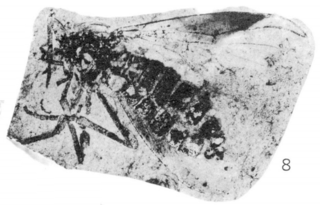
Plecia canadensis is an extinct species of Plecia in the fly family Bibionidae. The species is solely known from Early Eocene sediments exposed in central southern British Columbia. The species is one of twenty bibionid species described from the Eocene Okanagan Highlands paleofauna.
The paleofauna of the Eocene Okanagan Highlands consists of Early Eocene arthropods, vertebrates, plus rare nematodes and molluscs found in geological formations of the northwestern North American Eocene Okanagan Highlands. The highlands lake bed series' as a whole are considered one of the great Canadian Lagerstätten. The paleofauna represents that of a late Ypresian upland temperate ecosystem immediately after the Paleocene-Eocene thermal maximum, and before the increased cooling of the middle and late Eocene to Oligocene. The fossiliferous deposits of the region were noted as early as 1873, with small amounts of systematic work happening in the 1880-90s on British Columbian sites, and 1920-30s for Washington sites. Focus and more detailed descriptive work on the Okanagan Highlands site started in the last 1970's. Most of the highlands sites are preserved as compression-impression fossils in "shales", but also includes a rare permineralized biota and an amber biota.

Ulmus chuchuanus is an extinct species of flowering plant in the family Ulmaceae related to the modern elms. The species is known from fossil leaves and fruits found in early Eocene sites of northern Washington state, United States and central British Columbia, Canada.
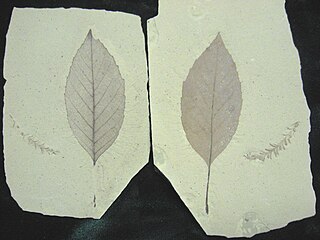
Alnus parvifolia is an extinct species of flowering plant in the family Betulaceae related to the modern birches. The species is known from fossil leaves and possible fruits found in early Eocene sites of northern Washington state, United States, and central British Columbia, Canada.















